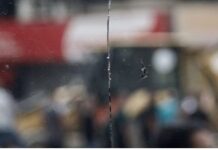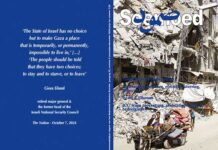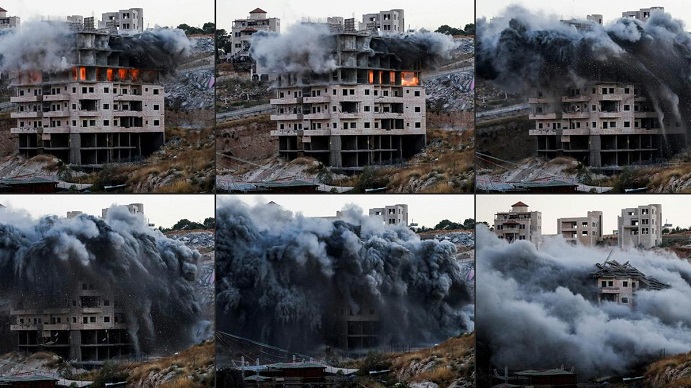Destruction at this scale and visibility cannot be understood without grasping its political message; in fact, the scale and visibility are the message.
The Nation / August 5, 2019
The act itself wasn’t unusual. Israeli demolition of Palestinian homes is a routine, almost daily occurrence. What set it apart was the scale, the impunity, and the political implications.
On July 22, the Israeli Civil Administration—that’s the Orwellian term Israel uses for its military government in the Occupied Palestinian Territory (OPT)—deployed 900 IDF soldiers and Border Police to demolish 13 apartment blocks, evicting 17 people in 70 apartments that were slated to house hundreds more in the Palestinian neighbourhood of Wadi al-Hummus, to the southeast of Jerusalem.
The action in July had all the elements of the slow-moving but relentless process of demolition that has plagued Palestinian life in both the OPT and within Israeli itself these past seven decades: Israel’s use of zoning, planning, law, and a Kafkaesque bureaucracy as mechanisms for taking all the Palestinian land available for the natural expansion of their towns, cities, and villages, while freezing Palestinian building in 1948, in the case of Israel, and 1967, in the OPT; Palestinians expending great financial resources they do not have in lengthy but ultimately futile appeals to the courts; the inevitable demolition of homes in violent military and police operations that leave whole families (whose only crime is wanting decent housing on land they own) physically bruised, often arrested and fined heavily, psychologically traumatized, and financially ruined—then watching helplessly as homes for Jews served by modern roads and infrastructures arise on those very lands they once owned and cultivated, lands that represented a decent future life for them and their children.
And as in 99 percent of the approximately 140,000 Palestinian homes systematically demolished since 1948—52,000 in the Nakba and in its wake, 55,000 in the OPT since 1967, tens of thousands more within Israel from after the Nakba until today (for which we cannot get reliable figures)—the demolitions in Wadi al-Hummus had nothing to do with security, or legality. The story, much of it related by Amir Cheshin and Avi Melamed, both advisers on Arab affairs to former Jerusalem mayor Teddy Kollek, and Bill Hutman in their book Separate and Unequal: The Inside Story of Israeli Rule in East Jerusalem is, briefly, this:
In 1967, Israel created a greatly expanded “east” Jerusalem out of lands taken from 28 Palestinian towns and villages in the West Bank that were conquered from Jordan. Although the new “east” Jerusalem was 10 times larger than it had previously been, the idea was that the vast lands now incorporated into Jerusalem would be for exclusive Jewish use in order to “Judaize” the city, not to serve the needs of their Palestinian owners, or even remain for long in their hands. The Israeli planning authorities drew tight lines around the already built-up Palestinian neighbourhoods and villages, declaring all the unbuilt-upon land, which had been used for agriculture or grazing and represented the only space into which the future Palestinian population could expand, “open green space.” This meant that Palestinians could own the land but not build upon it, since it was reserved for future urban development—i.e., future Jewish development. And the land, thus left unused, could easily be expropriated for Jewish settlement.
Today, when Palestinians make up almost 40 percent of the Jerusalem population, they still have access to only 8 percent of the urban land—and even there, they are routinely denied building permits. Lacking land, Palestinian “villages” in Jerusalem have become apartment blocks of five-to-10-story buildings jammed tightly together, with no green space, no infrastructure, no parking, no planning, and with whole families crammed into suffocating conditions. According to the draconian “Potential Housing Construction” policy adopted by the Israeli government and the Jerusalem Municipality, intended to maintain a 72-28 percent majority of Jews over Arabs in the city and to limit Palestinian construction to the already built-upon 8 percent, Arabs would be permitted to construct only tiny apartments in high-rise blocks on existing housing.
However, even this restrictive policy was resisted by the (all-Jewish) Jerusalem city council and the interior ministry. They therefore invented an Orwellian reason to justify why such building was not good for the Palestinians themselves: It would destroy the “village character” of their neighbourhoods. Thus mixing racist urban policy, the political use of zoning, and legal authority to restrict Palestinian construction by withholding building permits and demolishing homes built “illegally,” Israel effectively pursued apartheid under the guise of “proper administration.” And it did so while promoting itself as “the only democracy in the Middle East.”
In 1967, when the historically independent West Bank village of Sur Baher was annexed to Jerusalem in the wake of the Six-Day War, it had 4,700 residents living on about 10,000 dunams (2,470 acres) of land, most of them farmers or herders. Today Sur Baher has grown to 24,000, but has lost most of its undeveloped land. Some 2,250 dunams were confiscated in 1970 for the building of the East Talpiot settlement to the north; another 250 dunams were confiscated in the 1990s for the settlement of Har Homa to the south; and, over the years, more land has been expropriated for a major Israeli highway through Palestinian East Jerusalem designed to open up more territory for Israeli settlement. All the unbuilt-upon land that remains is frozen as “open green space.”
Indeed, according to the “Potential Housing Construction” policy, which limited Arab building in every East Jerusalem neighbourhood to levels that would not threaten the Jewish majority of 72 percent, only 2,350 new homes would ever be allowed to be built in Sur Baher. The only land available for expansion, then, was the 1,500 to 2,000 dunams still lying outside the municipal border, in Wadi al-Hummus in the West Bank, where the homes were demolished this July.
Under the Oslo II agreement of 1995, most of Wadi al-Hummus fell into what was defined in that agreement as areas A and B, which fall under the jurisdiction of the Palestinian Authority and outside of Israeli control. In 2003 Israel constructed its 12-foot concrete “security barrier” (which we call the Apartheid Wall) in that area, almost touching the homes of Sur Baher. When the residents threatened to turn to the Supreme Court, the army agreed to move the wall to the other side of Wadi al-Hummus, but only with the understanding that Israel was not relinquishing the right to expropriate the land for future Jewish settlement construction. A decade later, sensing no Israeli plans afoot and in desperate need of housing, the residents of Sur Baher and nearby Umm Tuba, mainly young families with nowhere else to live, applied for permits to construct homes from the only authority that had legal jurisdiction over it: the Palestinian Authority. Granted these permits by the PA, they began to erect mid-to-high-rise apartment blocks.
It is at this point, when the authorities have no genuine legal case, that the “security” card is typically played. Having no legal authority to stop the construction, the “Civil” Administration issued a sweeping new order: No Palestinian homes or structures could be built within 250 meters of the wall, an order that threatened not only Wadi al-Hummus but thousands of homes built near the wall—or, more usually, existing homes next to which the wall was built—along its circuitous 466-mile-long route through Palestinian cities, towns, villages, and farms. Since the Civil Administration runs the occupation via military fiat, with almost 2,000 military orders that constitute a corpus of law (in violation of the Fourth Geneva Convention), and since these orders are issued in Hebrew and are not generally communicated to the Palestinian public, it took some time before the Wadi al-Hummus residents even learned of the prohibition.
In the end, on June 11, the Israeli Supreme Court did what it traditionally does: Citing the “justiciability doctrine,” it declared security beyond its competence. It (virtually automatically) accepted the defense ministry’s position that the homes posed a security threat. That added yet another layer of illegality to the court’s decision. Not only was it patently illegal to demolish homes legally approved by the PA in an area under the PA’s clear jurisdiction, but this was done to protect the wall, itself built on Palestinian land and deemed “contrary to international law” by the International Court of Justice in The Hague in 2004, an advisory opinion that was adopted overwhelmingly by the General Assembly of the United Nations. As a result of the court’s decision, thousands of Palestinian homes existing within that buffer along the length of the wall can now be demolished. The Civil Administration has already announced that it has not finished its work in Wadi al-Hummus.
Other than demolitions carried out under the fog of war in such military operations as the 2008–09 invasion of Gaza, when more than 6,000 Palestinian homes were destroyed or damaged in three weeks, and the systematic destruction of entire Palestinian towns, villages, and urban neighbourhoods in the wake of the 1948 and 1967 wars, Wadi al-Hummus represents the largest single demolition in “peacetime.” A demolition of this scale and visibility cannot be understood without grasping its political message; in fact, the scale and visibility are the message.
After the collapse of former secretary of state John Kerry’s peace initiative in April 2014, the Netanyahu government informed the international community that any peace process was over, that the two-state solution was dead, and that negotiations with “the Arabs,” as we call them, were finished. That June, Israel initiated a search-and-destroy operation throughout the West Bank on the pretext of finding three kidnapped settler boys, who the authorities knew had been killed. A month after that, on July 8, the IDF opened yet another massive attack on Gaza, Operation Protective Edge, in which 485,000 civilians in the Gaza Strip were displaced. The Israelis’ message, then and now, is crystal clear: We do not recognize Palestinians as a “side” with legitimate national rights and claims, and we will no longer negotiate with them. The entire Land of Israel is ours, and we are taking possession of it. You Arabs have three options: Submit and accept the fact that you are living as either second-class citizens or noncitizens in a Jewish state; leave; or, if you choose to resist, die. Those are your stark options. Zero tolerance.
The message from Israel goes further: If you think the international community will come to your aid, just watch the reactions to our in-your-face demolitions. The US government supports us totally. A UN Security Council resolution condemning the Wadi al-Hummus demolitions was struck down by an American veto. The reaction of the EU (“The continuation of this policy undermines the viability of the two-state solution and the prospect for a lasting peace”) sounds almost computer-generated. China, Russia, India, Brazil, the Arab world, all traditional supporters of Palestinian rights? Far too indebted to Israeli arms and security technologies to ever impose sanctions.
This explains the scale, visibility, and violence of the Wadi al-Hummus demolitions. It is a gauntlet thrown in the face of civil society—us. What are you going to do about it? Unless we come up with a just political endgame (governments, preferring conflict management through an illusory “two-state solution,” won’t do it) and an effective strategy for mobilizing our forces, we will be left stewing in helpless outrage. Wadi al-Hummus screams: What are you going to do about it?
Jeff Halper is the head of the Israeli Committee Against House Demolitions (ICAHD) and the author of War Against the People: Israel, the Palestinians and Global Pacification (2015).













